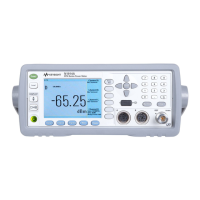Specifications and Characteristics 1
Keysight N1913/1914A Service Guide 25
Power Sensor Specifications
Definitions
Zero Set
In any power measurement, the power meter must initially be set to zero with no
power applied to the power sensor. Zero setting is accomplished within the power
meter by digitally correcting for residual offsets.
Zero Drift
This parameter is also called long term stability and is the change in the power
meter indication over a long time (usually one hour) for a constant input power at
a constant temperature, after a defined warm-up interval.
Measurement Noise
This parameter is also known as short term stability and is specified as the change
in the power meter indication over a short time interval (usually one minute) for a
constant input power at a constant temperature.
Accuracy
Instrumentation
Absolute accuracy
[1]
: ±0.02 dB (Logarithmic) or ±0.5% (Linear). (Refer to the
power sensor linearity specification in your power sensor manual to assess overall
system accuracy.)
Relative accuracy
[1]
: ±0.04 dB (Logarithmic) or ±1.0% (Linear). (Refer to the power
sensor linearity specification in your power sensor manual to assess overall
system accuracy.)
Zero Set (digital settability of zero): Power sensor dependent (refer to Table 1-1
and Table 1-2). For Keysight E-Series power sensors, this specification applies
when zeroing is performed with the sensor input disconnected from the POWER
REF.
[1] Refer to the power sensor linearity specification in your power sensor manual to assess overall
system accuracy.

